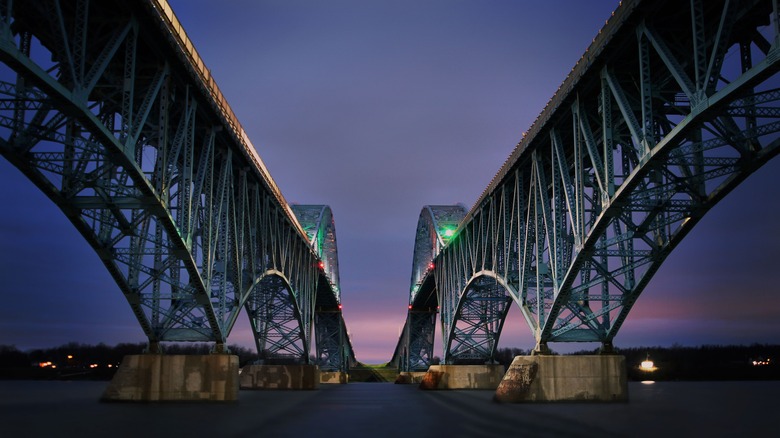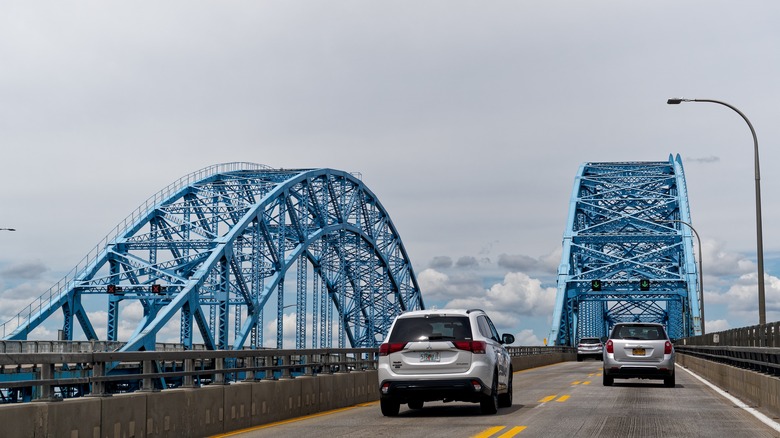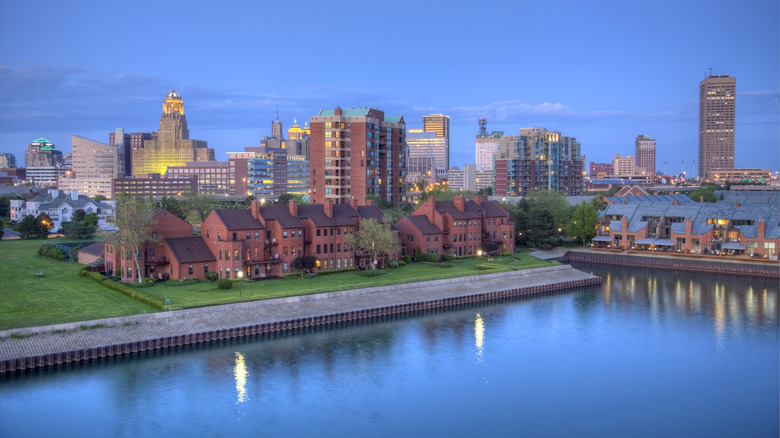Several Locals Are Terrified Of Driving On This Popular Bridge In New York
Lots of people hate to drive over bridges, and for good reason. Bridges are suspended in the air — by definition — over water or ravines or even other bridges. The widest bridge is still a confined environment, and what lies beyond its edge is a treacherous free-fall. Anywhere from 3 to 6% of us are clinically afraid of heights, and even if we're perfectly comfortable driving on bridges, there's always the chance an engine will stall, a battery will die, or a tire will blow. A broken-down car on a bridge is humiliating and stressful; traffic can back up for miles, and tow trucks struggle to cut through the gridlock. Then there's the parade of rubberneckers, resentfully driving past.
Worse yet is a bridge that's old and narrow, like the South Grand Island Bridge in New York. The landmark is actually two bridges, one northbound and the other south. The older one (southbound) was completed in 1935, and the second was built with the same design in 1963. Even if you didn't know that the original bridge has stood here for nearly a century, the steel-beam construction looks old, the kind of Industrial Age truss arch bridge that was once used for railroads. Unfortunately for gephyrophobes — people with a fear of crossing bridges — about 63,000 trips are taken over the South Grand Island Bridges every day, and a large percentage of those drivers are headed to nearby Niagara Falls, with all the attractions it has to offer.
3,400 feet of driving anxiety
Not only are these twin bridges long (more than 3,500 feet), but they're also high up: the South Grand Island Bridges span the Niagara River, a popular shipping route, and their central spans provide about 100 feet of clearance of passing watercraft. The central arches are also 400 feet wide, which means a huge amount of empty space beneath your car as you barrel down Interstate 190. As if that weren't unnerving enough, drivers are corralled onto two-lane roads only 24 feet wide, with no shoulder or place to pull off in an emergency. You may notice the sidewalks attached to both bridges, but the southbound walkway is closed due to safety concerns, according to the Federal Highway Administration.
Old infrastructure is a hot-button topic across the US, especially after the Pittsburgh bridge collapse in 2022, the truck fire and bridge collapse in Philadelphia in 2023, and the fatal Francis Scott Key Bridge collapse in Baltimore in 2024, all of which took place in similar "Rust Belt" communities. Few drivers are thrilled to drive over older bridges anyway, and many have anecdotally reported the South Grand Island Bridges feeling unstable beneath them. This is unfortunate, no matter whether you are heading to the romantic getaways in Upstate New York or simply heading out on the morning commute.
A brighter future in Western New York?
There's a lot of good news, though, that a passing tourist might not know about the South Grand Island Bridges and the wider region. The state is investing $39 million in repair work to the bridges, partially as a defense against future seismic activity — another imperceptible concern — and restoration will include improved walkways for pedestrians and cyclists. Meanwhile, the corroded girders were recently repainted, making the bridge look much more inviting. The bridge will always be narrow and high, but if you're an experienced driver, you may not fear the bridges so much as admire their vintage architecture.
These bridges are a major thoroughfare for residents of Buffalo, an underrated mill town packed with stunning architecture. The lakeside city of 270,000 has blossomed with innovative new businesses and some of the most affordable housing in the country. This is a good sign for Western New York, home to several of the most breathtaking state and national parks in the Empire State. About 14 million people visit Niagara Falls each year, and with a refurbished bridge and bustling new Buffalo, they will hopefully stick around to see what else is there.


